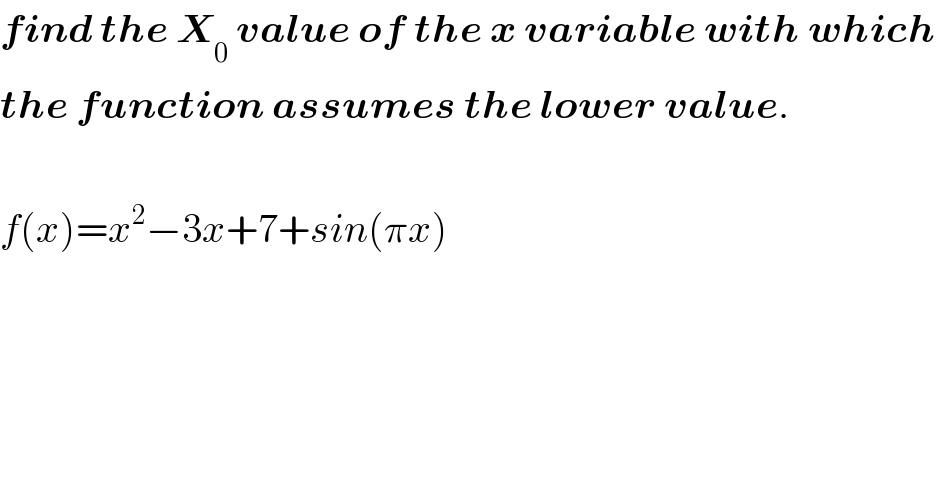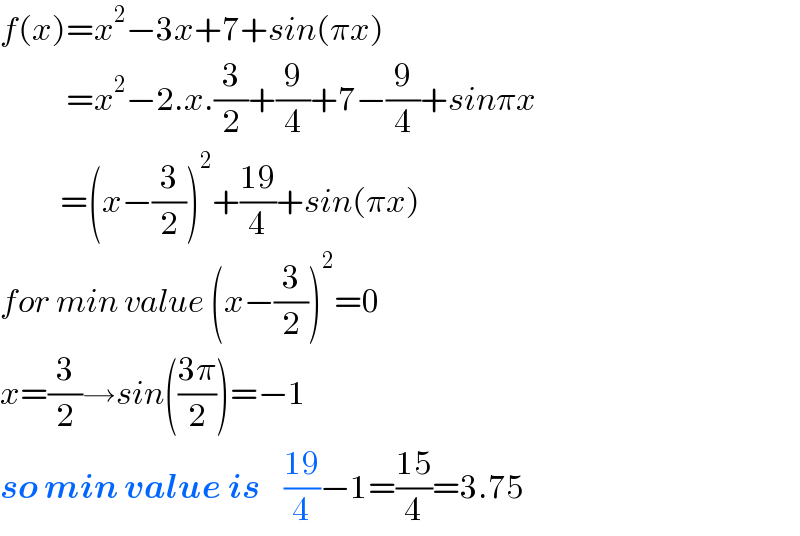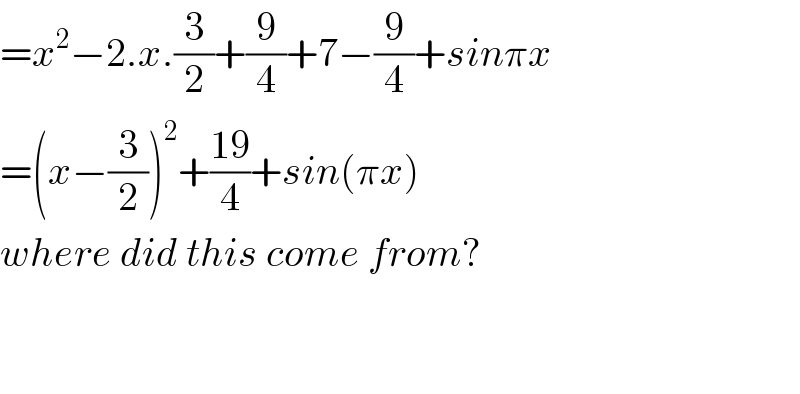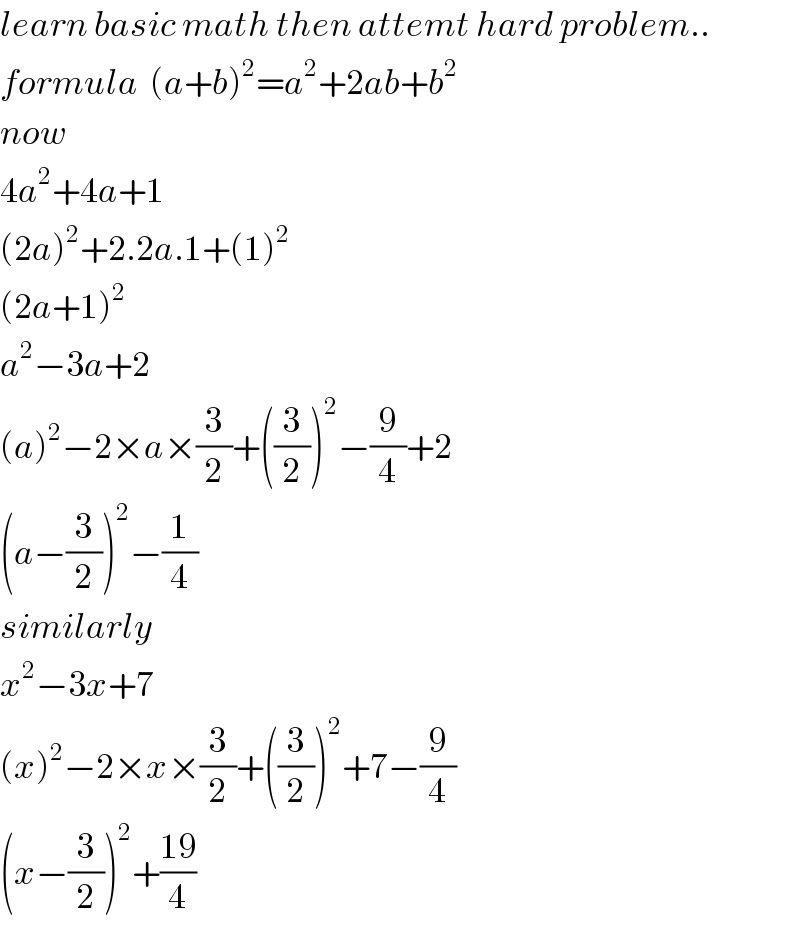
Question Number 56500 by kelly33 last updated on 17/Mar/19

$$\boldsymbol{{find}}\:\boldsymbol{{the}}\:\boldsymbol{{X}}_{\mathrm{0}} \:\boldsymbol{{value}}\:\boldsymbol{{of}}\:\boldsymbol{{the}}\:\boldsymbol{{x}}\:\boldsymbol{{variable}}\:\boldsymbol{{with}}\:\boldsymbol{{which}} \\ $$$$\boldsymbol{{the}}\:\boldsymbol{{function}}\:\boldsymbol{{assumes}}\:\boldsymbol{{the}}\:\boldsymbol{{lower}}\:\boldsymbol{{value}}. \\ $$$$ \\ $$$${f}\left({x}\right)={x}^{\mathrm{2}} −\mathrm{3}{x}+\mathrm{7}+{sin}\left(\pi{x}\right) \\ $$
Commented by kelly33 last updated on 17/Mar/19

$$ \\ $$$$ \\ $$$${plz}\:{help}\:{me} \\ $$
Answered by tanmay.chaudhury50@gmail.com last updated on 17/Mar/19

$${f}\left({x}\right)={x}^{\mathrm{2}} −\mathrm{3}{x}+\mathrm{7}+{sin}\left(\pi{x}\right) \\ $$$$\:\:\:\:\:\:\:\:\:\:\:={x}^{\mathrm{2}} −\mathrm{2}.{x}.\frac{\mathrm{3}}{\mathrm{2}}+\frac{\mathrm{9}}{\mathrm{4}}+\mathrm{7}−\frac{\mathrm{9}}{\mathrm{4}}+{sin}\pi{x} \\ $$$$\:\:\:\:\:\:\:\:\:\:=\left({x}−\frac{\mathrm{3}}{\mathrm{2}}\right)^{\mathrm{2}} +\frac{\mathrm{19}}{\mathrm{4}}+{sin}\left(\pi{x}\right) \\ $$$${for}\:{min}\:{value}\:\left({x}−\frac{\mathrm{3}}{\mathrm{2}}\right)^{\mathrm{2}} =\mathrm{0} \\ $$$${x}=\frac{\mathrm{3}}{\mathrm{2}}\rightarrow{sin}\left(\frac{\mathrm{3}\pi}{\mathrm{2}}\right)=−\mathrm{1} \\ $$$$\boldsymbol{{so}}\:\boldsymbol{{min}}\:\boldsymbol{{value}}\:\boldsymbol{{is}}\:\:\:\:\frac{\mathrm{19}}{\mathrm{4}}−\mathrm{1}=\frac{\mathrm{15}}{\mathrm{4}}=\mathrm{3}.\mathrm{75} \\ $$
Commented by tanmay.chaudhury50@gmail.com last updated on 17/Mar/19

Commented by kelly33 last updated on 19/Mar/19

$$={x}^{\mathrm{2}} −\mathrm{2}.{x}.\frac{\mathrm{3}}{\mathrm{2}}+\frac{\mathrm{9}}{\mathrm{4}}+\mathrm{7}−\frac{\mathrm{9}}{\mathrm{4}}+{sin}\pi{x} \\ $$$$=\left({x}−\frac{\mathrm{3}}{\mathrm{2}}\right)^{\mathrm{2}} +\frac{\mathrm{19}}{\mathrm{4}}+{sin}\left(\pi{x}\right) \\ $$$${where}\:{did}\:{this}\:{come}\:{from}? \\ $$$$ \\ $$$$ \\ $$
Commented by tanmay.chaudhury50@gmail.com last updated on 19/Mar/19

$${learn}\:{basic}\:{math}\:{then}\:{attemt}\:{hard}\:{problem}.. \\ $$$${formula}\:\:\left({a}+{b}\right)^{\mathrm{2}} ={a}^{\mathrm{2}} +\mathrm{2}{ab}+{b}^{\mathrm{2}} \\ $$$${now}\: \\ $$$$\mathrm{4}{a}^{\mathrm{2}} +\mathrm{4}{a}+\mathrm{1} \\ $$$$\left(\mathrm{2}{a}\right)^{\mathrm{2}} +\mathrm{2}.\mathrm{2}{a}.\mathrm{1}+\left(\mathrm{1}\right)^{\mathrm{2}} \\ $$$$\left(\mathrm{2}{a}+\mathrm{1}\right)^{\mathrm{2}} \\ $$$${a}^{\mathrm{2}} −\mathrm{3}{a}+\mathrm{2} \\ $$$$\left({a}\right)^{\mathrm{2}} −\mathrm{2}×{a}×\frac{\mathrm{3}}{\mathrm{2}}+\left(\frac{\mathrm{3}}{\mathrm{2}}\right)^{\mathrm{2}} −\frac{\mathrm{9}}{\mathrm{4}}+\mathrm{2} \\ $$$$\left({a}−\frac{\mathrm{3}}{\mathrm{2}}\right)^{\mathrm{2}} −\frac{\mathrm{1}}{\mathrm{4}} \\ $$$${similarly} \\ $$$${x}^{\mathrm{2}} −\mathrm{3}{x}+\mathrm{7} \\ $$$$\left({x}\right)^{\mathrm{2}} −\mathrm{2}×{x}×\frac{\mathrm{3}}{\mathrm{2}}+\left(\frac{\mathrm{3}}{\mathrm{2}}\right)^{\mathrm{2}} +\mathrm{7}−\frac{\mathrm{9}}{\mathrm{4}} \\ $$$$\left({x}−\frac{\mathrm{3}}{\mathrm{2}}\right)^{\mathrm{2}} +\frac{\mathrm{19}}{\mathrm{4}} \\ $$
Commented by kelly33 last updated on 19/Mar/19

$$ \\ $$$${where}\:{emerged}\:\frac{\mathrm{3}}{\mathrm{2}}\:{and}\:\frac{−\mathrm{9}}{\mathrm{4}} \\ $$
